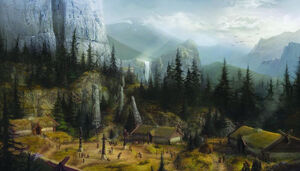
Avvar Village
The Avvars are a human tribe dating back to ancient times.
History
They were one of the tribes of the Alamarri. Although often referred to as a single entity, the Avvars are actually groups of small tribes who operate independently of each other. The only unifying concepts that the Avvars share are their beliefs and culture.
The Avvars fought against the Tevinter Imperium's advances on their land. With the help of dwarves they built the fortresses of Kinloch Hold, and Vigil's Keep. The former became the home to Ferelden's Circle of Magi, and the latter to Grey Wardens, after the Avvar power declined.
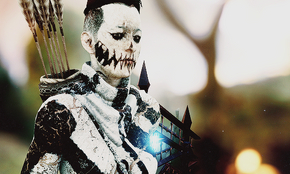
An Avvar archer decorated with warpaint
Following the First Blight, the Avvars made considerable advance on the Tevinter territory. Maferath, an Avvarian leader married to Andraste managed to conquer most of the Imperium before failing to capture Minrathous, with the help of other Alamarri tribes, and elven slaves led by Shartan. However, after the failed siege of Minrathous, Maferath betrayed his wife and worked out a secret deal with Archon Hessarian. In exchange for truce and the lands south of Kirkwall, the barbarians would give Andraste to the magisters.
The Avvars separated from the Alamarri some time after the First Blight, following a civil war. They took the inhospitable Frostback Mountains of the Alamarri lands to call them home.
By 6:50 Steel the Avvar are united under the great warlord Balak and attack the Bannorn in massive numbers. After two years however, they are pushed out of the Fereldan Valley. This conflict resulted in one of the worst famines in Fereldan history, while the relations of Ferelden with the Avvars remain very sour for centuries.[1]
Culture
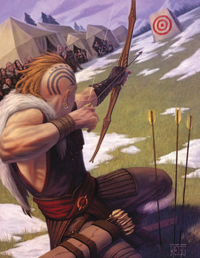
An Avvar Archer[2]
Non-Material
Permanence is a foreign concept to the Avvars. Nothing in the Frostbacks stays the same forever, and nothing in Avvar life is permanent either. Their settlements are temporary; their agreements are temporary; even their marriages are temporary. When two Avvars are married, the bride will sing a hymn to a select god while the groom attempts to undo a series of knots in a long rope. The number of knots the groom undoes before the hymn ends determines the number of years that marriage will last.
Since each Avvar hold is made up of several extended-family clans, Avvars must often marry outside their hold to avoid their relatives. They see this as a good thing, for it brings in new blood and extends the ties among Avvars. Avvar men go about securing brides by kidnapping them. This is partially arranged in advance by approaching the elders of the target clan and announcing one’s intention. Failure to do so can lead to a blood feud.
Once permission has been given, a warrior is expected to prove his skill by slipping into the hold and removing his new bride. A warrior who is caught on his first try can expect a severe beating, but nothing worse. If he is caught again on the second try, though, he is likely to become lunch for the clan’s sacred animal. Avvarian men may approach a lady directly if they wish to secure her agreement (or assistance), and some Avvar women make it known that they desire a specific man.
Avvars are expected to put loyalty to hold before blood. Even a kidnapped bride is expected to renounce her former ties and cleave to her new clan. Indeed, her old clan and family are forever after slightly suspicious of her, even if she was taken against her will.[3] Avvar hold all oaths close to sacred[4], but the final authority on them, the thane, can always find "a hole in the tent of any promise, a place for the cold wind to sneak in". To make up for breaking an oath with another hold, the party which has done wrong can pay the price of their transgression with gifts and new trade conditions. Spiritual rules are considered equally stringent.[5]
Avvar despise capture and would rather end their own life or die in battle than be prisoner to an enemy.[6]
For some clans, there are three parts to an Avvar name. These are the first name, the byname and the clan name. These clans tend to be matrilineal, so the byname is used to show who an Avvar's mother is. "An" would indicate "daughter of" and "Ar" would indicate "son of". The byname is followed "O" and then the name of the clan. For example, Arcill Ar Dubne O Wyrmhold would be the son of Dubne from the clan Wyrmhold.[7]
For other clans, a person is identified by a firstname and a surname, and the surname is determined by the firstname of a parent, such as Finn Caldansen being the son of Caldan.[8] The suffix "-dotten" is used instead of "-sen" in a woman's surname to indicate her as a daughter rather than a son.[9]
Avvar can also earn a "legend-mark" by accomplishing a great deed. A legend-mark is a cognomen that replaces the surname in honor of the great deed performed by the individual; e.g., Ivatt Jovsen was made Ivatt Stone-Thunder.[10] For one to inherit the family name, they must give a sufficient offering to the deceased former head of the family.[8]
Material
The majority of the Avvarian people live in subsistence conditions, with the greater part of their days spent gathering the necessities of survival with little time given over to activities without an immediate practical application. Ornamentation is rare among Avvar-made goods that aren’t religious in nature. They prefer well-made items that endure the Frostbacks’ extreme weather. Positions in a hold include Master of the Hunt, Thane, Augur, Skald and Arena Trainer. Homes are sturdily made of wood with thatched or peat roofs[11] and communal evening meals, prepared by both men and women, are taken around the fire.
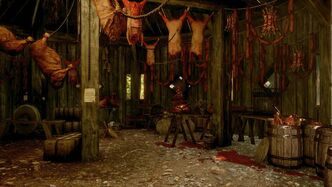
Meats must be preserved so that they will last the winter
The Avvar welcome any kind of meat, from snails to gurguts. Stews are common, as they can be easily prepared. Baked fish wrapped in clay and pungent leaves is a popular dish for holds settled near lakes or rivers. Most Avvar food preparation centers around winter: from the spring thaw onward, meat is smoked, vegetables pickled, fruits dried, everything stored in preparation for the long, cold winter of the Frostbacks.[12]
Though their culture has declined over the years, some Avvar clans still exist today. The existing clans live in holds that bear the name of the clan that live there.[13] Each hold also has a "hold-beast" that ties the clan to the gods. This animal acts as a sort of revered mascot and is treated as kin to the clan. It is no pet and is granted independence to live as it chooses. The clan may even offer it gifts of food though not enough that it would not hunt for itself. When a hold-beast is strong and happy, there is joy. When it sickens and dies, it is an ill omen.[14]
Foreign Relations
The Avvars have a decent relationship with the dwarven kingdom of Orzammar. The Avvars trade furs, goat milk, and free passage rights for dwarf traders (allowing them to travel over the Frostbacks in peace) in exchange for arms and armor. The dwarves regard the Avvars as a useful deterrent against both Fereldan and Orlesian ambitions.[3] The Avvars regularly trade with the dwarves of Orzammar in order to acquire fine weaponry and other supplies. This relationship extended back into the ancient times, as dwarves even surface in some ancient Avvar tales, such as the one below.
Tremble at the ice-troll Hryngnar, guard your gaze against his wrath,
Dead to dreams as dwarves below us, fools in folly block his path.
There is also limited commerce, dialogue and exchange of ideas with the Orlesian empire, and some Avvar holds may even be in possession of Orlesian books.[15] Some traders make their way to cities such as Lydes, Verchiel and Val Royeaux to trade furs and leathers for spices and things that the Avvar cannot make on their own.[16][17]
Politics
Each Avvar clan is led by a thane. Avvar settle disputes that don't have a clear right party by undergoing tests and trials. Usually these tests are dedicated to their spirit gods; for example, the "Test of the Lady" is a race to climb a rock face between two competitors, each of which represent a party or claim in the dispute. The Avvar have many of these trials and the procedures for each one varies. Thanes guide the gods in deciding who is worthy and decide which test will settle the dispute. Thanes also have the power to ask a warrior whose claim is foolish to bear a handicap in the test, such as to climb the Test of the Lady with stones strapped to his or her back. The test and conditions of the test regarding a dispute between two clans or more are assumed to be negotiated and coordinated by the thanes of the invested clans.
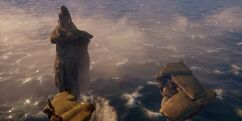
Village people fishing upon the rocks
Peace is maintained between clans by creating alliances and officiating them with oaths. Some clans swear to defend and avenge each other. Admittedly though, not all Avvar hold these oaths sacred, especially for clans who promise such oaths but bear little fondness to those they are sworn to. The realistic truth is that an oath lasts until they are broken. Even a cunning thane can find a loophole and should the oath-breakers emerge victorious through cunning, they can appease the other clans sworn to defend and avenge those they've transgressed against by sending offerings, trade and gifts, to pay the price of oath-breaking.[18]
Beliefs
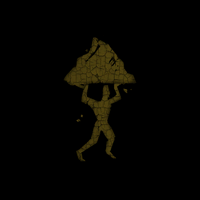
The heraldry of Korth
The Avvars still worship the old gods of the Alamarri, the chief among them Korth the Mountain-Father, Hakkon Wintersbreath, and The Lady of the Skies.[19] Andraste, a barbarian, is said to have prayed first to Korth and the Lady, but her prayers fell on deaf ears until the Maker answered.[20]
The Avvars also worship many lesser gods such as Uvolla, who is the god of the Wending Wood.[21]
It is nearly impossible to speak of the Avvarian people without speaking of their beliefs. Faith is the vibrant cornerstone of their existence, filling their harsh lives with sacred implications, for the Avvars believe as the Alamarri once did: The gods live in all things. Wind from an unexpected direction, birds flying in unusual patterns, a sudden silence amidst the high peaks in the spring—these are nothing but chance to a lowlander, but are messages from the gods to an Avvar.
The Avvars believe without question that their gods have protected them and kept them strong, for do they not thrive despite their numerous enemies? Wise lowlanders avoid pointing out that the hillsmen have been pushed into some of the most inhospitable terrain in all of Thedas. In truth, the Avvars love the Frostbacks and would only take offense at the thought that they were “forced” into the mountains.
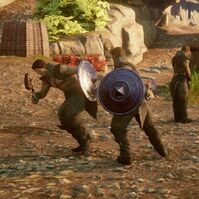
When warriors train, they are doing so for the gods. A warrior will know when the gods think them worthy when they receive 'a second of strength when (they) most need it, a glimpse that spots a blade through a heart.'-Arrken Feldsten
The Avvars have a complex pantheon, which includes both nature spirits and legendary mortals who have ascended to the heavens. This is further complicated by the fact that the pantheon varies somewhat from hold to hold, as every clan has its own sacred tales and heroes; however, all Avvars agree on the three greatest gods. These are Korth the Mountain Father, Hakkon Wintersbreath, and the Lady of the Skies. Imhar the Clever and the Great Bear Sigfost are also revered in most communities.[3]
The Avvars’ gods are more capricious than cruel, demanding appeasement for perceived sleights rather than wantonly casting misfortune on their people from lofty heights. When Avvars suffer, it seldom occurs to them to blame ill luck, but instead, to wonder which of the gods they have offended. If a warrior suffers a wound, he is concerned that he may have slighted Hakkon. If a hunting party returns emptyhanded, their only thought is to placate the Mountain Father; indeed, they will not go forth hunting once more until they have decided on how to mollify Korth - there would be no point in it, as they would surely fail again.[22]
The Avvar deem spirits as their gods, treating them as patrons to be lulled and wooed. The Avvar deliberately invoke spirits for strength in battle or solicit them for advice. Such spirits have lived with in their holds for many generations, and sometimes took the form of an animal or departed relatives when they pass on their wisdom. In the event a god is destroyed, the Avvar begin a year-long time of offerings and prayers and rituals. At the end of this period, a new spirit takes on the name and role of the old one.[23]
Avvar believe in a hazily defined afterlife governed by the "Lady of the Skies" where the dead are reunited with their kin. Avvar also believe some of their people are destined to be reborn, i.e., the essence (the soul) returns clothed in new flesh. The core of the concept is thus: the souls of a few Avvar "favored" by fate "migrate" on death to inhabit new bodies destined for them, so they may return and perform great deeds for the good of their hold. These resurrected souls are not expected to remember their past selves consciously, but instead are assumed to be subtly "guided" by their previous experiences, especially through visions and portents. [24]
Korth the Mountain-Father
- See also: Codex entry: Constellation: Belenas
Also known as the Father of the Skies,[25] Korth is the eldest and strongest god and everything found in the mountains stems from him. The Avvars believe all caves were carved by the Mountain-Father to shelter them, and that dwarves are also his creation as they live within his realm, deep underground.[26] It is through his benevolence the Avvars receive everything they need - be it prey for hunters or green fields for goatherds. If game is scarce, Avvars will seek to mollify Korth. The trial done is his honour is to battle in verse while being carried aloft by those who support a given participant.
Most Avvars believe Korth is as old as Frostbacks themselves, but the Winter Song of the ancient Frosthold clan tells otherwise. According to this song, which is sung during Wintersend, Korth was a hunter who brought his people to the mountains at the dawn of time.[27] The Avvars return their dead to Korth by leaving them out on the rocks in order to be picked clean by the birds.[25]
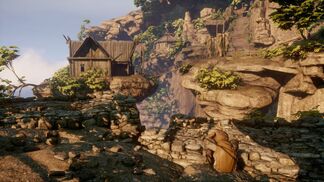
An Avvar woman tending the site of where a sky burial would take place
The Warden-Commander can interact with a Shrine of Korth located underneath the Vigil's Keep.
Lady of the Skies
The Lady is goddess of all above Korth's domain, of birds and even the wind itself. One legend states that an Avvarian tribe forsook Korth for the Lady, and were last seen with messengers of the Lady flying over their hold as Tevinter invaded.
She is also goddess of the dead. Rather than cremating their dead as Andrastians do, the Avvars dismember their dead and offer them to the Lady through her messengers, the birds, in what Ferelden scholars refer to as an "air burial" (also known as "Sky burial").[27] [28] For most, the body is laid out, and prayers given. When the bird comes, they carry the soul to the Lady of the Skies. The body, unneeded, is gone. Some souls are chosen to return- a blessing considered a rare honor. The augur reads the signs at birth to find such worthy individuals. In order to return, an offering provided by blood-kin and prepared by a huntsmaster is made to Korth the Mountain Father; and buried beneath the body. A piece of the soul thus remains, allowing the rest to return to the world and be reborn.[29]
Hawke can interact with a shrine dedicated to the lady in the Free Marches, which may indicate the Avvars once spanned the Waking Sea.
The ritual priests who worship the lady are known as Sky Watchers. Their religious duties primarily consist of reading the portents of the Lady of the Skies to interpret her will and presenting the bones of the deceased as offerings to her.
Hakkon Wintersbreath
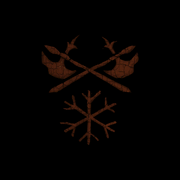
The heraldry of Hakkon
Hakkon is Korth the Mountain-Father's firstborn son, and Lord of War and Winter.[30] He is master of the two bitter colds of frost and steel, and respect for him and his power leads the Avvars to follow him into battle: they prefer to raid and wage war in winter, when their resistance to the cold gives them the advantage over lowlanders.[27]
Avvar warriors train in the martial arts in order to be found worthy by Hakkon and Hakkon in turn was said to grant such warriors who earned his favor with a natural intuition or a second wind during battle.[31] Some warriors who prove their vigilance, wisdom, or valor are granted special weapons to perform his will.[32][6][33][34][35] The test in his honour is to do battle with blunted weapons.
Sigfrost
The Great Bear sleeps at the foot of the Mountain Father's throne, and is so vast in size that Korth once confused him with a small mountain. Sitting at Korth's foot, he is also the guardian of wisdom. Avvars may challenge him to acquire knowledge, but the bones of many on such a quest are strewn about his den.
Avvars hold all bears sacred and, though they do sometimes hunt and skin them, do so with great solmenity. Due to this, they consider Bereskarn to be especially blasphemous as well.
Several Circle magi claim to have met Sigfrost in the Fade.[27]
Imhar the Clever
The trickster of the Avvar pantheon, Imhar is a slight man who must rely on his quick tongue instead of strength. Avvars enjoy tales of Imhar's jests and mockery, perhaps the most popular of which is that of Imhar and an evil seductress. She lured him into facing her unarmed, then faced him with an army of demons. Playing the coward, Imhar lead them on a merry chase through a mountain pass. When they thought they had cornered him, Imhar laughed out loud. The great noise shook the peaks, and the horde was crushed beneath the avalanche he caused.[27]
Uvolla
A god of the Wending Wood. Little is known of him. He appears to accept living sacrifice, however, in payment for wrongs done in his sacred place.[36]
Bjorn Reed-Beard
A god said to bless fishermen.
Rilla of the Fireside
A god whose blessings aid in the making of babies.
Avvarian shamans
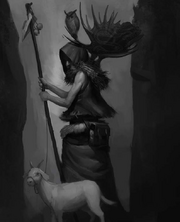
An Avvarian shaman[37]
When forced to consider complex spiritual matters, the Avvars turn to their shamans, the lore keepers of the mountains. It is they who watch the migrations of birds seeking wisdom from the Lady, they who keep the old songs and retain the knowledge of the proper rites to honor the gods and spirits of the mountains. The majority of the Avvars’ shamans are powerful mages whose traditions stretch far back beyond the foundations of the Circle of Magi.[22]
Neither the Chantry nor the Prophetess means anything to the Avvarians, and Templars are not welcome in the Frostbacks. This is wise, as many of the shamans' rituals would horrify the Chantry. Even mild rites invite spirits to speak through the casters for a time, to say nothing of some of their more powerful ceremonies. The Avvars are well aware that some spirits are reluctant to depart human hosts willingly, but they have means of dealing with such recalcitrant entities.[22] After all, they have no more desire to become abominations than other mages, and so their rituals are specifically designed to force the spirits back out as well.[38]
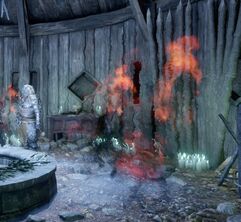
An Augur holding congress with spirits
The Avvar call these shamans augurs. Only one mage is chosen to be the augur. The augur's role is to give council to other mages and the thane. In turn, an augur takes council from the spirits they deem gods and shares it with the hold. The augur makes the clan's will known to the spirits and the spirits' will to the clan. By appeasing their spirit gods with rituals, the spirits in turn protect their hold and drive off spirits gone bad with rage or gloom. The augur also spots those who draw bad spirits and councils the thane how to deal with the matter. [9]
The augur allow their apprentices to be possessed by a summoned Spirit and the spirit teaches the mage how to control their magic with patience and kindness. When the teaching is done, the mage must then release the spirit through a ritual that involves burning an offering and casting a taxing spell that usually requires a vial of lyrium to replenish one's strength. If the ritual is not done then the abomination is to be exiled.[39] Weak mages unable to control their magic remain possessed and the Avvars' spirit gods watches them both so neither soul becomes corrupted. If the abomination becomes corrupted or the mage stands at risk of harming the hold, then one day the abomination simply dies in their sleep.[40]
Other duties of an augur include interpreting omens and preparing the dead to be taken back to the Lady of the Sky.
Known Avvar settlements
- Kinloch Hold (former)
- Redhold[41]
- Wyvern Hold[42]
- Fort of a Thousand Vigils (former)
- Stone-Bear Hold
- Skyhold (former)
- Fennec-Tooth Hold[43]
- Red-Lion Hold (that later became the Jaws of Hakkon)[44]
Involvement
Dragon Age (tabletop RPG)
Arl Gallagher Wulff's daughter, Izot, elopes with her Avvar lover Azur Ar Brosna O Redhold but is kidnapped by a rival Avvar warlord named Balan. While searching for her at the Arl's request, the adventurers visit Redhold, where Thane Oswyne attempts to enlist them to aid in the defense of the hold against a large Darkspawn raid.
Dragon Age: Origins - Awakening
The Warden-Commander can meet two Avvars turned into stone in the Wending Wood during the events of Dragon Age: Origins - Awakening.
The Warden-Commander is also attacked by a group of Avvars during a random encounter.
Dragon Age: Inquisition

Son of an Avvar chieftain
A group of dishonorable Avvar barbarians take over a castle known as Hargrave Keep in the Fallow Mire, and held a group of Inquisition soldiers hostage. Their leader, Hand of Korth, issues a challenge to Herald of Andraste, who must fight through the barbarians, including their leader, to rescue the soldiers. Amund, a Sky Watcher of the Avvar tribes, can be persuaded to join the Inquisition after the barbarians are defeated.
The Avvar tribal leader, Movran the Under, the father of the now dead Hand of Korth, will attack Skyhold's walls with a goat. The leader, easily captured, explains himself in court: Since The Inquisitor killed his son he responded according the Avvar tradition by staining The Inquisitor's holdings with goats blood.
Holding no quarrel with the Inquisition, he is actually glad to be rid of his 'idiot son.' The Avvar group that took their people captive were suppose to be dealing with Tevinter agents in the area but ended up contending with the Inquisition instead, and upon learning of the "Herald of Andraste" the Hand of Korth issued a challenge hoping to bolster his standing.
Movran and his tribe can be put on display in a gibbet, driven from Inquisition lands, 'Banished' to Tevinter with as many weapons as they can carry, making the tribesmen into makeshift Inquisition agents, or if Champions of the Just was completed, paired with Lord Abernache.
After the Inquisition establishes a presence in the Frostback Basin, the Inquisition is spurred by Professor Bram Kenric's archaeological findings to discover the fate of Inquisitor Ameridan- the Herald of Andraste's predecessor. The Herald align themselves with the Avvar tribe of Stone-Bear Hold and discover that the hostile Jaws of Hakkon seek to unleash their imprisoned god, Hakkon Wintersbreath, on all of Thedas out of revenge. The Inquisition discover that Ameridan has been keeping the dragon vessel of Hakkon confined with time magic, and after his bindings fail, passes on the duty to finish what he started to the Herald. The Herald foils the Hakkonite's plans and slays the dragon vessel of Hakkon.
Known Avvars
- See also: Category:Avvars
- Anashe, an Avvar tribeswoman and falconer[45]
- Amund, a religious shaman of the Lady of the Skies and agent of the Inquisition
- Balak, an Avvar warlord[46]
- Gurd Harofsen, a warrior from Red-Lion Hold and later leader of the Jaws of Hakkon
- Havard, the first of the Disciples of Andraste[47]
- Hand of Korth, the son of Movran the Under
- Elorn, Avvar shaman/mage[38]
- Kaelah, a woman who fled Ruadan to find shelter with the dwarves[48]
- Kell ap Morgan, a Jarl of the Avvars
- Kiveal, an Avvar who alongside the dwarves bound The Dark Theurge
- Lowenna an Aenor, an Avvar woman living in Redhold[49]
- Maferath, the husband of Andraste and a warlord in the time during the first Exalted Marches[47]
- Morrighan'nan, a chieftain of an Avvar clan[50]
- Movran the Under, chieftain of an Avvar clan from the Fallow Mire
- Ruadan, an Avvarian shaman and mage
- The spirit in the Statue of Peace
- The spirit in the Statue of War
- Svarah Sun-Hair, thane of the Stone-Bear Hold
- Tyrdda Bright-Axe, Avvar-Mother, referenced in codex entries gathered from landmarks in the Hinterlands; her clan is reputed to be the first of the Avvars, having migrated into the Frostbacks at the behest of Tyrdda's lover, a spirit in the form of an elf
- Stiksma, a giant of a warrior[51]
- Owyne ar Rainne, Thane of Redhold[41]
RPG Description
Inevitably encountered only in the midst of winter, unless one happens to be traveling through the heights of the Frostbacks, Avvars are skilled hunters and fierce combatants who exult in battle. They raid into the Fereldan lowlands under the cover of heavy storms, using the great cold to their advantage, as their mountain homes have all but inured them to its bite. Their treacherous homeland has taught them to avoid heavy armor. They prefer strong chain links, dwarf wrought if they can get it, wrapped in warm furs. Avvars favor axes and spears over swords. Their bows are heavy, with long shafts capable of piercing a man’s torso at great distance.
It is nearly impossible to catch a hunting party of Avvars unawares, due to their great skill at falconry. A hunting party will nearly always have a mountain eagle or two, highly clever and well-trained birds that scout for them. Indeed, Avvars are far more likely to ambush others than be caught themselves. The hot blooded Avvars are proud, honorable, and relish any opportunity to prove themselves superior to those they consider to be heretical lowlanders. A clever combatant with knowledge of the Avvars’ ways can try to use either their arrogance or their many superstitions against them.[52]
Related codex entries
- For a complete list, see [[::Category:Avvar lore]].
Trivia
- Originally, one of the human origins was going to be an Avvar barbarian.[53][54]
- A glimspe of what life is like for the Avvars can be seen in a scene in Dragon Age: The Calling, where Kell ap Morgan, a senior Grey Warden from among the Avvars, is trapped in a dream of his home.
- The Avvar warlord's name Balak could be derived from "Ka'hairal Balak" - a character from BioWare's game franchise Mass Effect and leader of a batarian terrorist group that raids Asteroid X57 in the DLC X57: Bring Down the Sky.
- In Awakening, the name of the god Hakkon is spelled Haakon.
- Sky burials are a Vajrayana Buddhism practice that takes place in Tibet, Mongolia and some parts of China, for the ground is too hard for graves to be dug. Several Native American tribes such as the Choctaw Nation, also had a similar ritual in involving bone cleaning.
- The Avvar refer to the Fade as the Land of the Dreams.
- In Inquisition, the Avvar chant and mumble like Venatori, though they would have no reason to speak Tevene.





